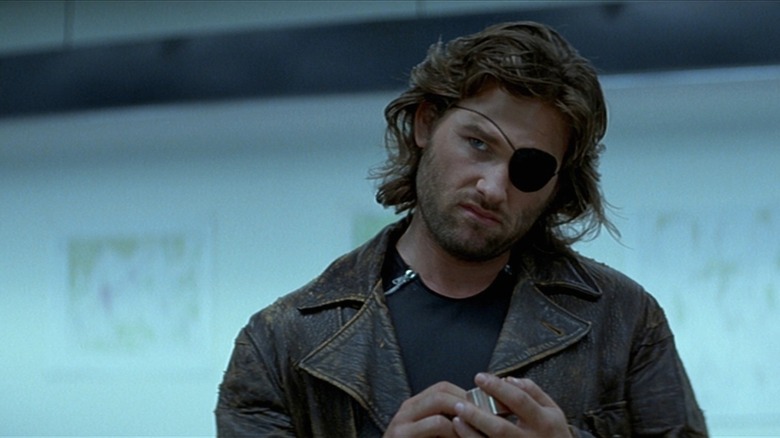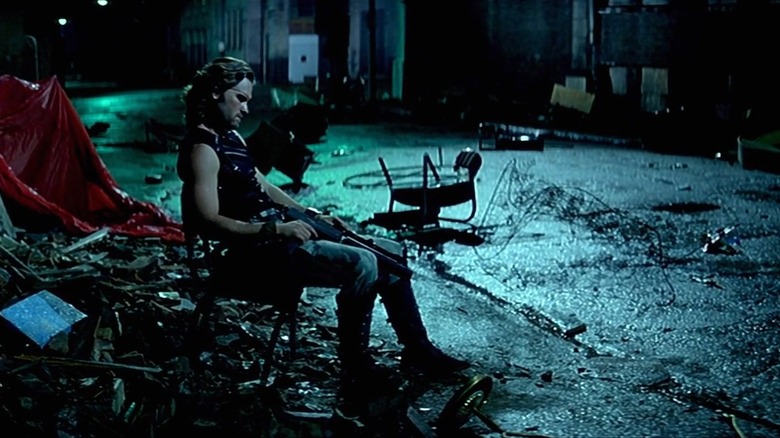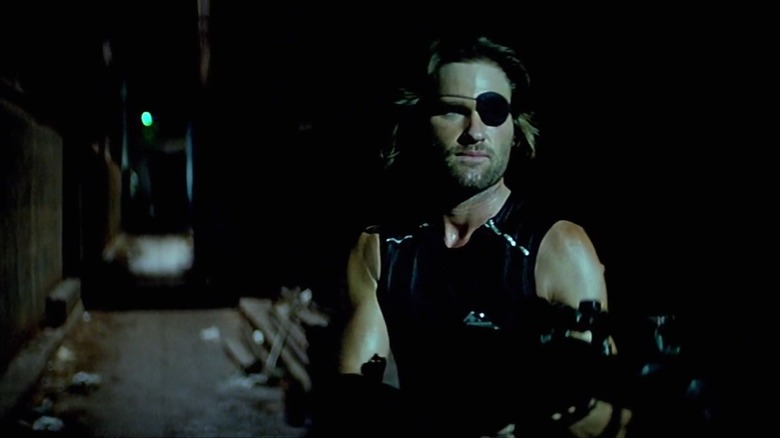Escape From New York Cut An Opening Scene That Completely Changed Kurt Russell's Character
John Carpenter's 1981 sci-fi film "Escape from New York" is set in the far-flung future of 1997 when crime in across America has suddenly increased 400%. In response, the government has walled off the island of Manhattan, transforming the entire city into a massive prison. Food is airdropped in every so often. All escape bridges are lousy with landmines. There are no guards apart from those walking the parapets. It's a lawless land with no escape. Any criminals and ne'er-do-wells are forced inside and left to their own devices.
The protagonist of "Escape from New York" (I hesitate to call him a hero) is Snake Plissken (Kurt Russell), a freelance badass and thief who was recently apprehended by the government (represented by Lee Van Cleef). Snake is told that Air Force One has exploded over New York, and an escape pod containing the president (Donald Pleasence) has landed inside the New York prison. Snake is told he needs to trek into New York to retrieve the president — and quickly — or else a time bomb implanted in his neck will explode. Snake hates everything about the mission, but agrees to save his own skin. By the end of the movie, Snake will not become a better person, nor will he learn any lessons.
Snake's stoic punk rock dismissal of the world, some might say, is his most appealing trait. Snake is heartless and indifferent and that's what makes him relatable. He's a walking middle finger. But Snake wasn't always like that. Russell, recently talking to GQ, talked about a famously excised opening sequence in "Escape from New York" that would have depicted Snake showing some actual compassion. Carpenter shot an impressive heist sequence in one take, only to cut it, feeling it added fat to the story and made Snake too humane.
Snake Plissken, genuine psychotic
Russell looks at Snake Plissken differently from the character's fans, seeing the grizzled, Clint Eastwood-like badass as a wounded, kind of pathetic figure. Russell sees Snake as an escape artist who can escape from New York (and Los Angeles in his 1996 sequel), but "he's doomed to never be able to escape the one thing he wants to escape from, and that's himself." For Russell, Snake is a survivor, but also psychotic, two qualities, he says, that "go together." There is no softness to Snake. Which makes for an exciting sci-fi hero, but not a complete human.
Russell recalls making "Escape from New York," notably the opening scene that was deleted. In the theatrical cut, Snake is introduced already in police custody. In the original script, audiences were to see what he did to get arrested. The deleted opening heist sequence has been released to the public and can easily be seen online. The sequence made use of Panaglide camera rigs to achieve the long takes. Carpenter has said that he only shot the sequence to show off.
Russell noted why the sequence was cut, saying:
"We started out doing some stuff that ended up not being in the movie. It was a train station sequence sort of establishing the character of Snake. And he had a partner, and he got shot, and Snake actually ran back to help him. They caught them. It was a redeeming quality is what we were showing there. John Carpenter decided, correctly so, that Snake didn't have any redeeming qualities ... I only cared about pleasing John. And, hopefully, trying to capture something that was going to fit into his vision."
Remove Snake's humanity. Check. It was a wise choice that actually improved the character.
Poor Taylor
Snake's heist partner was a character named Bill Taylor who is not mentioned in the rest of the film. Taylor is played by an actor named Joe Unger who also appeared in other notable genre films like "A Nightmare on Elm Street," "Road House," "Leatherface: The Texas Chainsaw Massacre III," and "Pumpkinhead II: Blood Wings." The joke of the heist sequence is that Snake and Taylor aren't stealing cash, but a satchel full of futuristic credit cards. In an uncharacteristic flourish, Snake hands the take over to Taylor, saying "I trust ya," before laughing to himself at how unlikely that was. Had the heist scene been included in the movie, it would be the only time audiences would have seen Snake smile.
The sequence also took the action away from New York, taking place mostly in San Francisco. Snake and Taylor were ambushed by police at a BART station by well-armed cops, with Snake giving them the slip and Taylor getting shot. Although he was in the clear, Snake shouted back to his partner and then ran back up a staircase to get him, missing his train. The outward, demonstrative concern and affable conversation were antithetical to what Carpenter wanted Snake to be, so the entire sequence — no matter how impressive — was wisely left on the cutting room floor.
At the end of the film, after Snake has indeed escaped from New York, the antihero has a chance to kill the Lee Van Cleef character, revenge for the harrowing mission he was sent on. Instead, he merely says that he's too tired and that perhaps he'll kill him later. That scene says more about Snake than the heist sequence. Sure, he could commit murder, but he's rather rest and be left alone.


